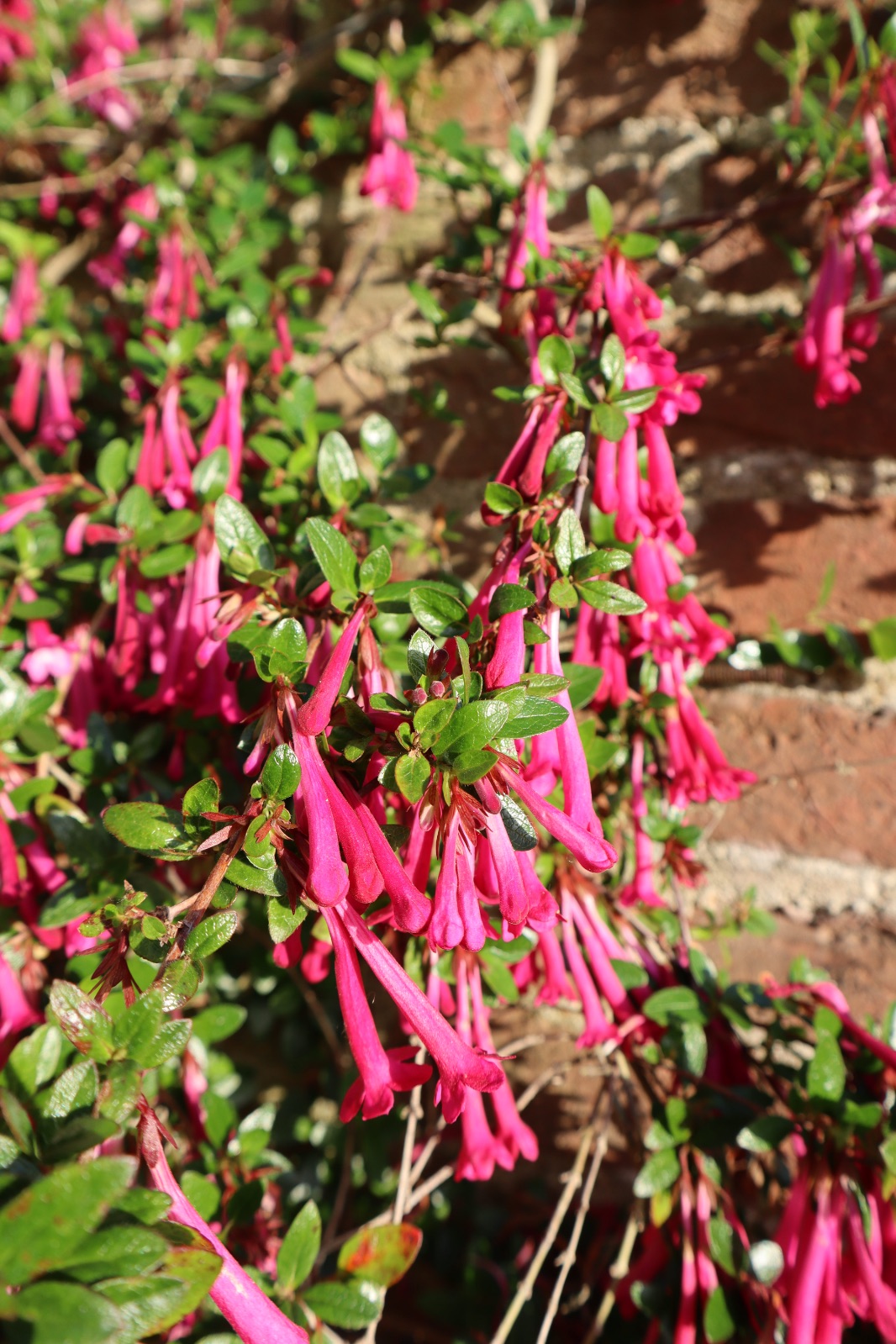Vesalea
Sponsor
Kindly sponsored by
The Normanby Charitable Trust
Credits
Owen Johnson (2021)
Recommended citation
Johnson, O. (2021), 'Vesalea' from the website Trees and Shrubs Online (treesandshrubsonline.
Family
- Caprifoliaceae
Common Names
- Mexican Abelia
A genus of about 5 species of deciduous shrubs to 2 m tall (or in the wild with leaves withering in the spring dry season). Shoots greyish, old bark often fibrous. Buds in opposite pairs, with several pairs of scales. Leaves orbicular to elliptic, 3–40 × 2–25 mm, often leathery; petiole short. Inflorescence a raceme on short shoots with single or paired flowers. Flowers pendulous; peduncles short; calyx lobes 5, sepals lanceolate, 3–7 × 1–2 mm; corolla tubular to funnel-shaped, not gibbous at the base, 1–4.5 cm long, reddish-purple to indigo, rarely marked in the throat, usually with glandular hairs; corolla lobes 5, each slightly 2-lipped. Nectary formed of 1 or more lines of compact glandular hairs located in grooves in the corolla tube. Stamens 4, filaments glabrous; style glabrous. Fruit a wind-dispersed achene with a short apical neck, 1-seeded, ridged and topped with 5 persistent sepals. Seeds ovate, 1.5–3 mm long. (Landrein & Farjon 2020).
The generic name Vesalea was published in 1844 by the Belgian botanists Martin Martens and Henri Galeotti, commemorating (for whatever reason) the 16th century Flemish anatomist André Vésale. All of its species are endemic to the mountains of Mexico and represent the New World equivalents of Abelia (and its allies) from eastern Asia; distinctive features which have arisen during Vesalea’s long period of isolation include the crimson to purplish, slender-throated flowers. These features are most strongly expressed in V. floribunda (M. Martens & Galeotti) Landrein, whose flowers are also scentless; these are adaptations to pollination by hummingbirds, instead of by butterflies and other insects (Landrein & Farjon 2020). Hummingbirds’ vision is especially acute at the red end of the spectrum and their slender bills are variously adapted to sipping nectar from flowers with long throats, but they lack a sense of smell.
Botanists – in contrast to biologists – traditionally prefer to group many and varied plants within single genera, and through the 20th century it became conventional to treat these Mexican shrubs as a part of the genus Abelia. Genetic studies have more recently shown Abelia to be an artificial amalgamation of plants which are not very closely related, and one nomenclatural solution to this issue, followed here, has been to resurrect the old generic name Vesalea for the Mexican species. The alternative strategy, proposed by Maarten Christenhusz (Christenhusz 2013), is to submerge most of the plants historically known as Abelia, along with their allies, within an even more diverse genus, for which Linnaea L. is the first published name. (See the generic introductions to Abelia and to Linnaea for further discussion of this issue.) The consequences of this nomenclatural instability are, for now, that information on these Mexican plants can be found more or less evenly spread under the generic names Abelia, Linnaea, and Vesalea. The vernacular name ‘Mexican Abelia’ is suggested here for the group.
Such name-changes can be particularly vexing for the wider horticultural community, but, in this case, Vesalea floribunda M. Martens & Galeotti is the only species at all well-known in cultivation (at least under its old name, Abelia floribunda Decne.). It has much the longest flowers in the group, and also the southernmost distribution, and genetic analysis has shown it to be a sister-species to the others (Landrein & Farjon 2020).
The other species tend to have isolated or relic populations in various mountain-ranges across Mexico. V. subcoriacea (Villarreal) Landrein, with a relatively widespread distribution in the north of the country, is cultivated at the San Francisco Botanical Garden (Landrein & Farjon 2020). V. coriacea (Hemsley) T. Kim & B. Sun ex Landrein has only been recorded from a proposed building site on the outskirks of the city of San Luis Potosí and is not known to be in cultivation; it was assessed by Landrein and Farjon (Landrein & Farjon 2020) as Critically Endangered and we must hope it has not been buldozed to extinction. V. mexicana (Villarreal) H.F. Wang & Landrein and V. occidentalis (Villarreal) H.F. Wang ex Landrein were first described in 2000 by José Villarreal (as Abelia mexicana and A. occidentalis respectively). V. occidentalis is restricted to two small areas along the Sierra Madre Occidental and does not seem to be in cultivation; it is assessed by Landrein and Farjon (Landrein & Farjon 2020) as Endangered. V. mexicana has two disjunct populations, var. grandifolia (Villarreal) Landrein, assessed as Vulnerable, and var. mexicana Wang et al., which is also cultivated at the San Francisco Botanical Garden and which is assessed as Endangered (Landrein & Farjon 2020).
Identification key | ||
| 1a | Corolla tubular, 2.5–4.5 cm long; flowers single, unscented, with nectaries in three lines: | Vesalea floribunda |
| 1b | Corolla funnel-shaped, fragrant, 1–3 cm long, with the nectary in a single line: | 2 |
| 2a | Corolla 2–3 cm long; leaves with dense, stiff hairs under the main veins: | V. mexicana |
| 2b | Corolla 1–1.8 cm long; leaves without dense stiff hairs: | V. subcoriacea |

